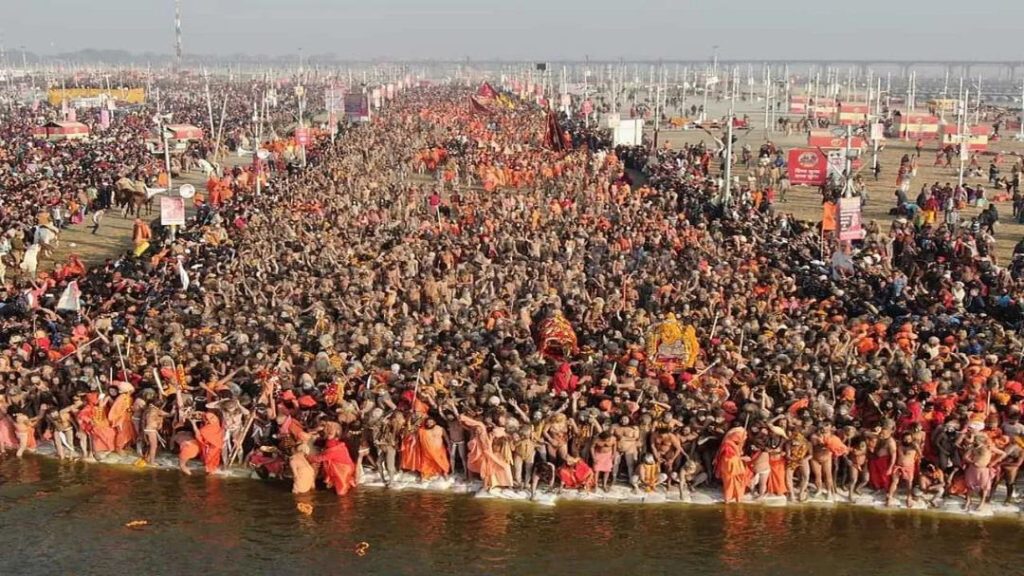
Ganga, Yamuna Waters Highly Contaminated, Says CPCB
The sacred waters of the Ganga and Yamuna rivers, which millions of devotees take a dip in as part of the Kumbh ritual in Prayagraj, are highly contaminated with human and animal excreta, according to the Central Pollution Control Board (CPCB). This revelation contradicts the claim made by a Union minister that technology contributed by nuclear centres is keeping the river waters clean.
The CPCB’s findings are a cause of concern for experts, who are worried about the possible diseases that could be caused by bathing in such contaminated water. The Kumbh Mela, one of the largest religious gatherings in the world, is currently underway in Prayagraj, and millions of devotees have taken a dip in the rivers as part of the ritual.
The CPCB’s report highlights the alarming levels of fecal contamination in the rivers. According to the report, the fecal coliform bacteria count in the Ganga River is 34.3 times higher than the permissible limit, while the Yamuna River has a count of 23.5 times higher than the permissible limit.
The report also highlights that the fecal contamination is not limited to the riverbanks, but is also present in the water body. This is a major concern, as it indicates that the water is not safe for bathing, drinking, or any other human activity.
The CPCB’s findings are a stark contrast to the claim made by the Union minister that technology contributed by nuclear centres is keeping the river waters clean. The minister had claimed that the nuclear technology was capable of removing pollutants and pollutants from the river water, making it safe for bathing and other human activities.
However, experts have questioned the minister’s claim, saying that the technology is not capable of removing fecal contamination from the river water. “Fecal contamination is a major concern, and it requires immediate attention,” said Dr. Rakesh Kumar, a water expert. “The minister’s claim is misleading, and it’s not based on scientific facts.”
The CPCB’s report has also highlighted the need for immediate action to tackle the issue of fecal contamination in the rivers. The report recommends the installation of sewage treatment plants and the improvement of the drainage system to reduce the amount of fecal matter entering the rivers.
The state government has also announced plans to improve the sewage treatment capacity in the region. According to the government, the capacity of the sewage treatment plants will be increased from 150 million liters per day to 250 million liters per day.
However, experts are skeptical about the government’s plans, saying that it’s not enough to address the issue of fecal contamination. “The government’s plan is too little, too late,” said Dr. Kumar. “The issue of fecal contamination requires a comprehensive approach, including the installation of sewage treatment plants, improvement of the drainage system, and education and awareness programs.”
The Kumbh Mela, which is expected to attract millions of devotees, has also raised concerns about the safety of the water. The Mela authorities have announced plans to provide bottled water to the devotees, but experts are worried about the long-term effects of bathing in contaminated water.
“The Kumbh Mela is a major religious gathering, and it’s a concern that the devotees are bathing in contaminated water,” said Dr. Kumar. “The devotees are not aware of the risks associated with bathing in contaminated water, and it’s a major public health concern.”
The CPCB’s report has also highlighted the need for greater public awareness about the issue of fecal contamination in the rivers. The report recommends education and awareness programs to educate the public about the risks associated with bathing in contaminated water.
In conclusion, the CPCB’s report highlights the alarming levels of fecal contamination in the Ganga and Yamuna rivers, which is a major concern for public health. The report also contradicts the claim made by the Union minister that technology contributed by nuclear centres is keeping the river waters clean. The government’s plans to improve the sewage treatment capacity are too little, too late, and a comprehensive approach is required to address the issue of fecal contamination.






